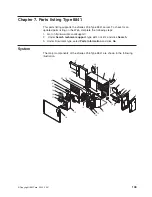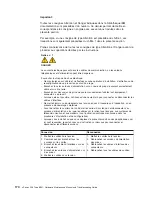
5.
Check
for
any
obvious
non-IBM
alterations.
Use
good
judgment
as
to
the
safety
of
any
non-IBM
alterations.
6.
Check
inside
the
unit
for
any
obvious
unsafe
conditions,
such
as
metal
filings,
contamination,
water
or
other
liquids,
or
signs
of
fire
or
smoke
damage.
7.
Check
for
worn,
frayed,
or
pinched
cables.
8.
Check
that
the
power-supply
cover
fasteners
(screws
or
rivets)
have
not
been
removed
or
tampered
with.
Handling
electrostatic
discharge-sensitive
devices
Any
computer
part
containing
transistors
or
integrated
circuits
(ICs)
should
be
considered
sensitive
to
electrostatic
discharge
(ESD).
ESD
damage
can
occur
when
there
is
a
difference
in
charge
between
objects.
Protect
against
ESD
damage
by
equalizing
the
charge
so
that
the
server,
the
part,
the
work
mat,
and
the
person
handling
the
part
are
all
at
the
same
charge.
Notes:
1.
Use
product-specific
ESD
procedures
when
they
exceed
the
requirements
noted
here.
2.
Make
sure
that
the
ESD-protective
devices
you
use
have
been
certified
(ISO
9000)
as
fully
effective.
When
handling
ESD-sensitive
parts:
v
Keep
the
parts
in
protective
packages
until
they
are
inserted
into
the
product.
v
Avoid
contact
with
other
people.
v
Wear
a
grounded
wrist
strap
against
your
skin
to
eliminate
static
on
your
body.
v
Prevent
the
part
from
touching
your
clothing.
Most
clothing
is
insulative
and
retains
a
charge
even
when
you
are
wearing
a
wrist
strap.
v
Use
the
black
side
of
a
grounded
work
mat
to
provide
a
static-free
work
surface.
The
mat
is
especially
useful
when
handling
ESD-sensitive
devices.
v
Select
a
grounding
system,
such
as
those
in
the
following
list,
to
provide
protection
that
meets
the
specific
service
requirement.
Note:
The
use
of
a
grounding
system
is
desirable
but
not
required
to
protect
against
ESD
damage.
–
Attach
the
ESD
ground
clip
to
any
frame
ground,
ground
braid,
or
green-wire
ground.
–
Use
an
ESD
common
ground
or
reference
point
when
working
on
a
double-insulated
or
battery-operated
system.
You
can
use
coax
or
connector-outside
shells
on
these
systems.
–
Use
the
round
ground-prong
of
the
ac
plug
on
ac-operated
computers.
Grounding
requirements
Electrical
grounding
of
the
computer
is
required
for
operator
safety
and
correct
system
function.
Proper
grounding
of
the
electrical
outlet
can
be
verified
by
a
certified
electrician.
156
xSeries
236
Type
8841:
Hardware
Maintenance
Manual
and
Troubleshooting
Guide
Summary of Contents for xSeries 236 8841
Page 1: ...xSeries 236 Type 8841 Hardware Maintenance Manual and Troubleshooting Guide...
Page 2: ......
Page 3: ...xSeries 236 Type 8841 Hardware Maintenance Manual and Troubleshooting Guide...
Page 20: ...10 xSeries 236 Type 8841 Hardware Maintenance Manual and Troubleshooting Guide...
Page 96: ...86 xSeries 236 Type 8841 Hardware Maintenance Manual and Troubleshooting Guide...
Page 152: ...142 xSeries 236 Type 8841 Hardware Maintenance Manual and Troubleshooting Guide...
Page 160: ...150 xSeries 236 Type 8841 Hardware Maintenance Manual and Troubleshooting Guide...
Page 173: ...Appendix B Safety information 163...
Page 174: ...164 xSeries 236 Type 8841 Hardware Maintenance Manual and Troubleshooting Guide...
Page 175: ...Appendix B Safety information 165...
Page 176: ...166 xSeries 236 Type 8841 Hardware Maintenance Manual and Troubleshooting Guide...
Page 177: ...Appendix B Safety information 167...
Page 178: ...168 xSeries 236 Type 8841 Hardware Maintenance Manual and Troubleshooting Guide...
Page 179: ...Appendix B Safety information 169...
Page 189: ...Appendix B Safety information 179...
Page 190: ...180 xSeries 236 Type 8841 Hardware Maintenance Manual and Troubleshooting Guide...
Page 191: ...Appendix B Safety information 181...
Page 192: ...182 xSeries 236 Type 8841 Hardware Maintenance Manual and Troubleshooting Guide...
Page 196: ...186 xSeries 236 Type 8841 Hardware Maintenance Manual and Troubleshooting Guide...
Page 208: ...198 xSeries 236 Type 8841 Hardware Maintenance Manual and Troubleshooting Guide...
Page 209: ......
Page 210: ...Part Number 25K8114 1P P N 25K8114...
















































